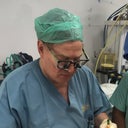I have performed many SMAS facelifts and neck lifts for over 30 years and have performed many minimally, invasive SMAS facelifts. Dimples can sometimes occur, with the more invasive type facelifts, from swelling around the retaining ligaments of the cheek. This causes a temporary dimple but requires no intervention. As the swelling subsides the dimple will disappear. However, the reality is that there are many different ways to perform a facelift from incision length, incision placement, level of tissue dissection (skin only, SMAS, Deep Plane, Subperiosteal), different degrees of tissue undermining, how to lift and support (imbrication versus plication of the SMAS layer), how much excess skin to trim, is excess fat going to be reduced and finally will the overall shape of the face be made more feminine or masculine (while avoiding the over pulled, windswept appearance). You would have to ask your facelift surgeon what caused the dimple. If a deep suture is the cause, it may need to be released (permanent suture) or allowed to dissolve (dissolvable suture).





